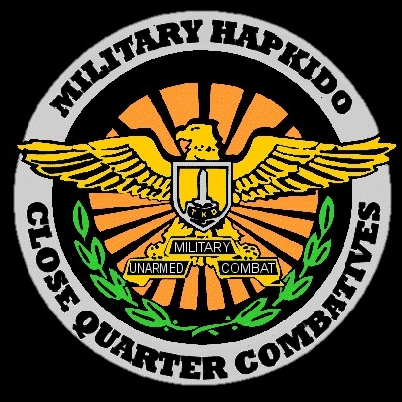 MILITARY HAPKIDO
MILITARY HAPKIDO
HISTORY OF HAPKIDO
The martial art of hapkido was developed in Korea in the mid-1900s. The creation of hapkido was heavily influenced by the Japanese arts of aikijujutsu. Hapkido is a dynamic and eclectic Korean martial art. Hapkido means " the way of coordinated power'. The techniques of Hapkido are combative, not competitive. Even the practice of hapkido can result in devastating injuries and must be undertaken with extreme caution. Hapkido is considered one of the most effective and practical martial arts in the world. It is taught to military personnel, police forces, special forces, security units and bodyguards worldwide. Hapkido employs the philosophy of using minimal force to overcome a stronger opponent. Therefore, great strength is not needed to apply the techniques effectively. Circular motion, non-resisting movements, and control of the opponent are emphasized over using strength against strength. Hapkido employs joint locks, as well as kicks, punches, and other striking attacks. There is also the use of weapons. Hapkido contains both long and close range fighting techniques, utilizing kicks and percussive hand strikes at longer ranges and pressure point strikes, joint locks, or throws at closer fighting distances.
MILITARY HAPKIDO
Military Hapkido or Kuk Bang Hapkido as it is known in Korean was developed in Canada by Grand Master Gus Michalik. The system has been recognized through the World Ki-do Federation and the Korean Government through the martial arts federation known as Han Min Jok Hapkido Association. Military Hapkido is not an orthodox form of Hapkido. Military Hapkido is a modern style of Hapkido which liberally incorporates elements of other combat systems. No patterns or huyngs are practiced. Training includes hand-to-hand combat, grappling and weapons disarming which uses Joint Manipulations, Take Downs and Vital Striking to control or destroy your attacker. This style is strictly self defense oriented and does not lend itself to sport or competition. Training is dynamic and based on modern combat principles. Military Hapkido does not incorporate certain techniques found in orthodox Hapkido such as acrobatic break falls, Arial kicking, forms, or meditation. Absent from Military Hapkido also are traditional weaponry such as the Fan or Sword.
TECHNIQUES
Military Hapkido teaches techniques and tactics applicable to all ranges of combat. Hand and leg strikes are taught in addition to joint manipulations, take downs and throws, trapping, and ground fighting. The bulk of Military Hapkido training is dedicated to situational self defense techniques and scenario based training.
WEAPONS Military Hapkido teaches practical weapons techniques. You can learn how to effectively use a short stick, knife and other common weapons such as a firearm. You can also learn how to disarm firearms and other weapons. Military Hapkido does not teach esoteric weaponry. Students will learn:
Military Hapkido teaches practical weapons techniques. You can learn how to effectively use a short stick, knife and other common weapons such as a firearm. You can also learn how to disarm firearms and other weapons. Military Hapkido does not teach esoteric weaponry. Students will learn:
-Dan Gum Sul - Knife Fighting Techniques
-Jung Gum Sul - Machete Fighting Techniques
-Horangi Paltop Gum Sul - Tiger Claw Knife Techniques
-Jung Bong Sul - Middle Stick Techniques
-Chong Sul - Firearms ( Hand Gun, Rifles, Shotgun )
GROUND COMBATIVES
Our Ground combative course focuses on learning and applying the fundamental techniques of ground fighting. Students learn and practice, escapes, positioning, self defense and counters. This is not a sport submission grappling course. All techniques and tactics shown are focused on realistic ground survival.
BELT RANKINGS
Military Hapkido has 8 different belt levels.
-Yellow
-Orange
-Green
-Purple
-Black 1
-Black 2
-Black 3
-Black 4
CLICK HERE TO SEE THE RANK REQUIREMENTS